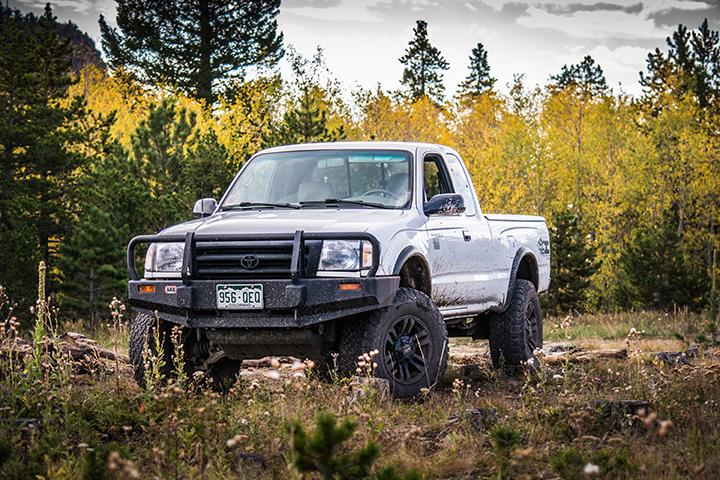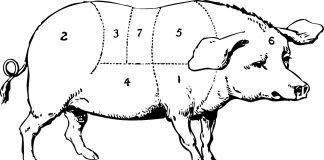|
 |
||
| Issue #71 • September/October, 2001 |
After spending more than 35 years living in homesteads that were so out of the way that we were snowed in for six months out of the year or, at the very least, living on roads that were inhospitable to normal vehicle traffic, you might say I’ve had a little experience with four-wheel drive.
No, I don’t race in four-wheel drive rallies, go mud bogging on the weekends, or own a monster truck. But we do own and use a beat-up Chevy pickup with four-wheel drive every day, from muddy summer to snowbound winter. You see, at our house, which is six miles from a plowed road, up two pretty awe-inspiring mountain switchbacks of two-rut trail, a four-wheel drive truck is not a play thing, but a vital tool of our very lives.
And I’ll bet a lot of self-reliant folks are in the same boat with us. We haul wood, hay, and feed for our animals, building materials, water (in a 200-gallon polytank), haul out game animals harvested at hunting season, pull out stuck neighbors, even if they live a few miles away, and much more. At our place, a two-wheel drive truck is out of the question. It would be deadly dangerous to drive one up here in the Big Belt Mountains.
But just owning a 4X4 is not enough. It takes plenty of know-how and seat-of-the-pants instinct to get the most out of one.
Choosing a four-wheel drive for backroad use
|
There are a lot of four-wheel drive vehicles out there today. But they are definitely not equal. A Jeep will get you in and out just fine, but I wouldn’t choose one for homestead use. We need one for hauling. Not only do we haul using the box, but we pull a 16-foot stock trailer, as well. For this much utility, you need a pickup, preferably a three quarter ton pickup. A smaller vehicle, such as a Chevy S10, doesn’t have the power or weight to constantly carry a big load or pull a large trailer, especially over less than adequate roads.
I’ve seen a lot of folks out here in the mountains of Montana and elsewhere trying to get by with an all-wheel-drive SUV or mini-van. And I’ve pulled a lot of them out of the ditch, too. Our truck is our only vehicle and it works like a horse. But you can’t expect a pony to do the work of a horse.
When choosing a four-wheel drive pickup, go for tough and mechanically sound over “fancy” or “pretty.” Chrome won’t get you out of a mud hole. Nor will that awesome stereo. You don’t need a “monster truck” or extra wide tires. We’re talking about utility here.
As for make, everyone has their preference, and I won’t argue for my choice. They are all good if taken care of well. I shy away from diesels, as they can get stubborn about starting in extremely cold weather, even with modern glow plugs, and I can’t take the noise and smell. But again, that’s your choice.
Tires?
I like a 10-ply, good quality (but not pricey) relatively aggressive tread mud/snow tire that is also acceptable on the highway, as we live over 50 miles from a city. Notice that I say 10-ply, not 10-ply rated. Big difference when you drive a lot of terrible trails year-round. (Not only do we live in a remote area, but we spend a lot of time driving places “normal” humans wouldn’t think of driving. We explore hundreds of miles of Montana’s National Forests every year.)
With less than 10-ply tires, you’ll have a lot of stone cuts and bruises, poke studs through tires, and be pretty unhappy. We drive ’em nearly bald and very seldom have a flat, and when we do it’s usually a wire or nail.
You don’t need pretty white letters. Our ugly black tires roll right past those sexy tires on trucks stuck on forest service roads.
Carry a good sparetwo if you’re in really remote country. We helped a hunter once who had blown two tires on rocks, and he was 60 miles from a service station. Luckily, he was driving a truck that was able to use one of our spares to get him out.
Be sure you have a four-way tire iron, a chunk of pipe to use as an extension just in case that air wrench had more muscle than you do, and a good jack. Most folks who run the back country carry a high-lift jack. That’s not to look macho. Sometimes you get so stuck you need lots of lift to get out. Jacks are not just for changing flats. Four-wheel drives are great, but when they get stuck, they really get stuck.
Miscellaneous 4X4 gear
A good winch can be a life-saver. If you buy a winch for the front end of your pickup, get a good, heavy-duty one, capable of hauling either your truck out of a major mess or helping get someone else out. You don’t want a lightweight toy. A snapping winch cable is deadly.
Our truck has both a C.B. and a cell phone. (We are so far off the beaten path we have no other phone, so for us a cell phone is “normal” not “fancy.”) We have both given help and received help using both.
Carry at least one shovel. Getting unstuck is much easier when you have something to dig with. And during forest fire season, a shovel is a necessity in the woods. Last summer, with Montana burning, we also included a tank of water and other fire-fighting gear.
We always carry a 20-foot tow chain. Seldom does a month go by that we don’t pull someone out of a stuck-hole or ditch. And if we should get stuck, we know it’ll be a lot easier to get pulled out if we have a chain. Not everyone with a 4X4 carries one; they can’t help you if no one has a chain.
Tire chains
If you travel off the roads, you might be able to get by not using tire chains. If you live off the roads, you need a full set of chains for your 4X4. While a four-wheel drive truck is pretty good in lousy weather, chaining up all the way around makes it get up and go.
|
Normally, only one set of chains will get you in and out comfortably. But when things get really hairy, you’ll need a set for both front and rear tires. This way, all four tires will pull with minimal slipping.
The chains will also help prevent sliding down slick trails, possibly averting disaster.
Normally, one thinks of tire chains for winter driving. But we’ve used them a lot during the summer on slick mountain trails. You don’t want to drive a chained-up truck in soup, as you will destroy a trail. But when things get slick, a set of chains will let you creep along, leaving only little marks instead of deep ruts from spinning. We don’t drive when we will rut up the roads. Erosion caused by poorly driven 4X4s is unforgivable.
Don’t skimp when buying tire chains for your truck. Get heavy, studded chains. Forget cables and other car tire gear. We’ve got a set with plate tighteners on six places around the tire. You can put a ratchet extension in the center and reef the chains really tight in seconds. And tight tire chains don’t slip off, break, or slap fenders.
When buying chains, also get a couple extra hooks and repair links to carry with you.
Most tire chains require bungee cords to keep tight. As with the chains, don’t skimp. Buy good, black rubber bungees, at least two for each tire. Cheap bungees will break and only last a few uses.
Using tire chains
The ideal chaining up area is a flat, dry, clear area. In such a place, you can be chained up on all four in 15 minutes. My husband and I can chain up our pickup in 10 minutes, working together.
|
Lay the chains out in front of each tire you’ll be chaining up; in moderate uses, we often chain up only the fronts. This gives better control on turns and pulls uphill well. In greasy mud or ice, we usually chain up the rears, and in really slick mud or deep snow we go for chaining up all four.
It’s easiest to place the hook ends of the chains next to the tires. Then when you drive ahead, the loop end of the chain is pulled up over the tire. Be sure to have the chains laid out wide and straight, so that the tire is centered on the chain when you move forward 18 inches or so.
Shut off the truck and be sure it can’t roll. Reach under the truck and hook the inside first. Boosting the chain a bit to the inside and over the top will help hook it short enough. Then boost it back, hoisting it up from the front of the tire to the top to gain enough slack to hook the outside hook as tight as possible. Get both sides hooked very tightly.
Fasten all hooks, including the bungee hooks, away from the tire. We’ve seen some hooks puncture tires when fastened facing the tire.
Most tire chains do not come with tightener plates. So we must resort to bungees to take out the remaining slack in the tire chains. Use fairly short bungees and make an X across the wheel. Two for each chain is adequate.
If need be, you can also chain up your truck after you’re stuck. This is less than ideal, but can be done with patience. Shovel a clear spot out in front or behind the tire; whichever will work. Then lay the chains very close to the tire. When the chains are in place, carefully and slowly, spin the chain under the tire, trying to stop on top of the chain. With luck and a little practice, you can then quickly chain up and rock out of your problem.
This can be dangerous, so be very careful, especially when you have a helper with you; thrown chains and sliding vehicles can easily kill. You can drive for short periods on paved roads, but they will quickly wear out chains if overused on pavement.
Four-wheel driving tips
Driving a 4X4 is like ballroom dancing; you can’t just go ramming around or you will spend a whole lot of time being embarrassed. With a four-wheel drive truck, you have a lot going for you: the four-wheel drive, high clearance, weight, and momentum.
Learning to use them all to the best advantage is what I call seat-of-the-pants experience. Sometimes a person knows what they should do in a given situation, but their body doesn’t respond. The best example of this is learning to step on the gas when in certain out-of-control situations, instead of stepping on the brake, which is the old “normal” response.
Most folks drive too darned fast, especially on back roads, with their four-wheel drives. And they slide off the trail, break axles, pop tires, and wear out trucks like my 10-year-old son wears out jeans. We can’t afford all that stress and expense. So we drive slowly, under control. “Stuff” happens; at 15 miles an hour on a mountain trail, you have more time to get out of trouble, before it gets serious, than at 45.
Instead of using speed to get through heavy going, try using momentum. Really watch the road ahead of you. If you’re coming to a mud hole, snow drift, or steep hill, get rolling a ways before the problem, then let the momentum provided by the truck’s weight and gentle speed rock you through the spot. This beats the heck out of spinning and sliding because you were in trouble before you tried to speed up.
When tackling a slippery downhill trail, stop and shift into low-range granny and power down the hill. This gives much more control than braking downhill, which always results in sliding, a scary thing in most instances. Use low-range granny for those steep, rocky uphill climbs too; you’ll break fewer parts and get there safer if you don’t charge uphill like a racer. We can’t afford to break parts on our truck. Leaping and bouncing over rocks is not our style.
One added benefit with a pickup is that in bad going you can throw extra weight in the back end. We stack half a ton of hay, firewood, or even shovel snow in if we need to get somewhere we really shouldn’t. My husband Bob shoveled snow in the back when a neighbor ran out of firewood midwinter. They drove up the mountain, shoving snow with the headlights, till they reached a wood pile. After emptying the truck box of the snow, they filled it up with firewood and returned to the freezing neighbor’s home. Extra weight adds to the power of the four-wheel drive and adds momentum to carry the truck through bad going.
Remember that having a four-wheel drive does not mean that you can zoom along without a worry. You can’t stop any easier than with a two-wheel drive vehicle.
You’ll learn, after driving a four-wheel drive on back trails for awhile, that a constant speed will not work as well as varying speed to fit road conditions and contours. On bad roads, one needs to be constantly “driving with your eyes,” deciding where to put the tires, how much speed is necessary, how to best use momentum, judging clearance, etc.
And one of the most important lessons I’ve learned is to gently rock a stuck truck back and forth until I’ve gained enough momentum to help shove the truck out of a bad place. Spinning the tires is futile and only digs a grave.
We enjoy the challenge of four-wheel drive living and are always evolving in learning what we can do with one. In a past winter, when snowed in by a mile of drifted snow, we planked out on top of the six feet of snow. That is, we drove our chained-up truck on top of four 16-foot roughsawn 2×10 planks the entire mile. We slipped off once in awhile and spent a day or two digging down to dirt, then planked up out of the hole. But in two weeks we had planked out the whole mile. We laugh today because we didn’t have to get out, but just wanted to try it, and it worked. Our Chevy snowshoes.


















This is a wonderful article! And a woman! I’m impressed! Most gals are kinda ‘girlie’. I’m a retired teamster and would LOVE to be outa this city. I just would like to say that this article was most inspiring, thank you!